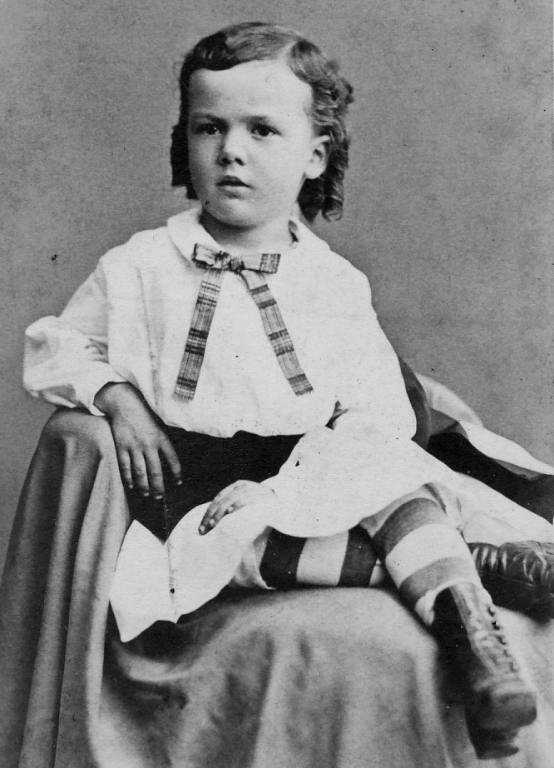
United States Boys' Clothes: Skirt Faric Patterns

Figure 1.--This unidentified Philadelphia boy was photographed by Gilbert Bacon. The CDV portrait is undated, but looks as if it was taken in the early-1870s. The boy wears a blouse with a modest collar and cross tie. His skirt looks like it was dark at the top and white at the bottom. That it was something we rarely see. Notice the ringlet curls and boldly striped stockings.
|
|
We notice boys wearing blouses with skirts done in various fabric patterns. Many of the portraits we have found with boys wearing skirts show the skirts done in a plaid or a plaid-like pattern. Thisincludes both skirts with out any kilt details as well as actual kilt construction elements. Dark muted plaids were common. We note some solid color skirts and some with a bold stripe at the hem. These are not nearly as common as the plaid one. Here we use the term plaid loosely. Some seem more like checks, but the trend is very notable. We believe that this pattern was particularly popular for boys because it suggested a kilt rather than a skirt. we are not entirely sure about the gender conventions. Girls might wear plaid also, but it was not nearly as common as for boys. We think girls more commonly wore dresses than skirts in the 19th century, but are not entirely sure of this.
Many of the portraits we have found with boys wearing skirts show the skirts done in a plaid or a plaid-like pattern. Thisincludes both skirts with out any kilt details as well as actual kilt construction elements. Dark muted plaids were common. We also see other patterns, bolder than usually used for kilt suits. Many of the portraits we have found with boys wearing skirts show the skirts done in a plaid or a plaid-like pattern. Thisincludes both skirts with out any kilt details as well as actual kilt construction elements. Dark muted plaids were common. We note some solid color skirts and some with abold stripe at the hem. These are not nearly as common as the plaid one. Here we use the term plaid loosely. Some seem more like checks, but the trend is very notable. We believe that this pattern was particularly popular for boys because it suggested a kilt rather than a skirt. we are not entirely sure about the gender conventions. Girls might wear plaid also, but it was not nearly as common as for boys. We think girls more commonly wore dresses than skirts in the 19th century, but are not entirely sure of this.
Solid Colors
We note some solid color skirts and some with abold stripe at the hem. These are not nearly as common as the plaid one.
Split Patterns
We notice boys with split pattern skirts. The boy wears a blouse with a modest collar and cross tie (figure 1). His skirt looks like it was dark at the top and white at the bottom. That it was something we rarely see.
HBC

Navigate Related HBC pages
[Ringlet curls]
[Blouses]
[Ties]
[Skirts]
[Long stockings]
[Footwear]
Navigate the Boys' Historical Clothing Web Site:
[Return to the Main U.S. skirt page]
[Return to the Main U.S. kilt page]
[Return to the Main U.S. skirted garment page]
[Return to the Main U.S. country garment page]
[Introduction]
[Activities]
[Biographies]
[Chronology]
[Clothing styles]
[Countries]
[Bibliographies]
[Contributions]
[FAQs]
[Glossary]
[Images]
[Links]
[Registration]
[Tools]
[Boys' Clothing Home]
Created: 3:34 AM 2/28/2009
Last updated: 7:35 AM 5/19/2010



